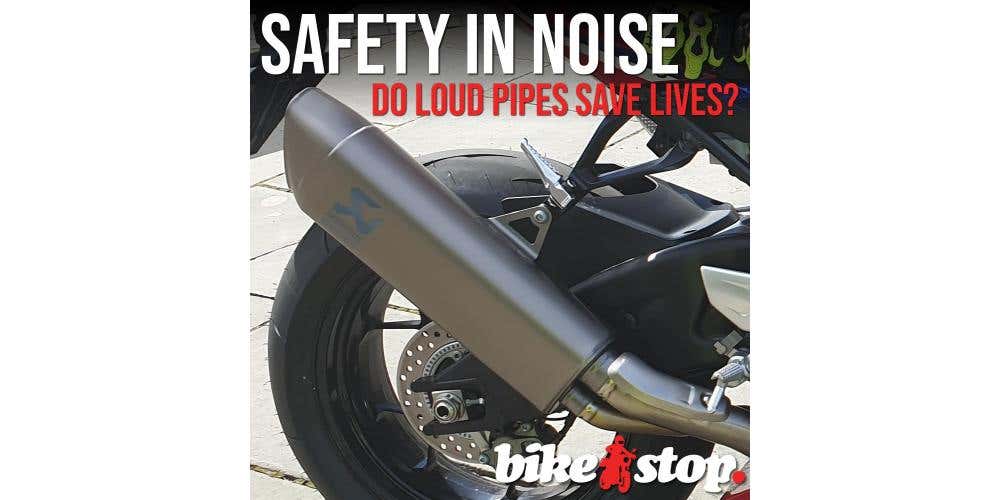It's a phrase you hear a lot when you ride motorbikes. Inside darkly lit pubs, outside coffee shops or around bike dealers where hordes of bikers gather together to talk about all things bike. Sooner or later - and typically after someone has just arrived on a bike louder than a small war - the phrase pops out of someone's mouth: "Loud pipes save lives."
Do they, though? Is there any science behind this, or is it used purely as an excuse to fit an exhaust similar in dimensions to a large beer can? As someone who hasn't bothered to change the exhaust on my last seven bikes, I'll hold my hands up now and say this article isn't going to be without a bit of bias. However, I'll try to remain as objective as I can. If you're wondering why I'm not a huge fan of loud exhausts, it's simply because I don't really get it. The last bike I changed an exhaust on was my 2007 GSX-R750 K7. The midrange gixer was a great bike, and even the standard exhaust was a suitably discreet stubby affair. Nevertheless, friends encouraged me to replace it with something meatier, meaner and more growly. After seeking recommendations, I replaced the standard can with a little MTC exhaust.
All credit to the boys and girls at MTC; the quality of the exhaust was flawless. However, it was too loud for my taste. Whilst the sound was tolerable for me on spirited rides, I could never entirely escape the feeling that the sound would be annoying someone somewhere. Every time I rode through a picturesque hamlet or chocolate-box village, I felt guilty that I'd be disturbing someone's peaceful Sunday. Nothing drains my soul quicker than a sweet old lady giving me a disapproving look from her front garden whilst she prunes her bush.
On longer rides with lengthy stretches of A-roads or motorways, the incessant droning drove me to distraction. Sometimes it would become so tedious and monotonous that I'd find myself flicking through the gears to endure a different monotone for a while. Needless to say, this wasn't the most economical or fun way of riding. Ultimately, I removed the exhaust and replaced it with the standard unit. Going back to OEM, whilst in horror and disbelief to my riding buddies, was a relief to my neighbours. Few people would choose to live next to someone cold-starting a GSX-R inside a small garage each morning.
Sound of Silence
At face value, the argument that loud pipes save lives seems logical. Loud noises get noticed. Emergency vehicles have sirens, cyclists have bells, motor vehicles have horns and cows moo. On the subject of motorbikes, even my grandma can hear a MotoGP bike from a mile away, and she died in 1983. However, the amount of noise generated is largely irrelevant compared to how it's heard. The sirens of emergency vehicles and car horns differ from loud exhausts in one important way: they face forward. The sound follows the bike rather than precedes it.
It's not just the direction of sound that's the problem, either. A series of tests conducted by the Association for the Development of Motorcycling in Romania, in conjunction with the Department of Road Vehicles at the Polytechnic University of Bucharest, provided some interesting results. The tests were created to determine how much noise would actually reach the ears of car drivers. Using different scenarios and positions, testers measured the sound heard inside the car with the windows up and the car's engine running between 2,500-3000rpm, and the car's radio playing music at 20dB.


To give some context, 20dB is around the level of whispering. 40dB is the background noise of a quiet office with nobody talking, 60dB is the level of normal conversation between two people, 80db is a loud vacuum cleaner, 100dB is a woodchipper, 120dB is the sound of an emergency services siren, and 140dB is how loudly I scream when a reality TV star appears on my television and starts talking about politics. Anyway, back to the tests.
The testers positioned six different motorcycles - all bouncing off the redline - in four positions: 50ft behind the car, 33ft behind the car, next to the car and directly in front of the car. Noise levels from the bike were registered at 80-110dBA. Believe it or not, the motorcycles positioned 50ft behind the car could not be heard by the occupants of the car. Even at 33ft, only the faintest bike noise could be heard - and remember, the bikes are redlining.
With the bikes' front wheels positioned in line with the car's rear wheel - a typical blindspot danger position - only one of the motorcycles could be heard from inside the car. Three of the motorcycles could 'just about' be heard, and the remaining two were undetectable. However, even if you were being particularly generous and claimed all bikes could be heard from inside the car at some level, the position of the bike means it's far too late. If you've ever filtered in heavy traffic and had a car move out on you when you were very close to them, that's one reason why.
Reality and Solutions
In reality, the tests were perhaps particularly generous in favour of the bikes. My anecdotal experience would suggest that car drivers tend to listen to music a lot louder than 20dB. They may also be distracted by eating their breakfast, applying makeup, watching cat videos or sending offensive messages to people on Facebook. The biker's reality is that they're unlikely to be running at full rpm all the time. So really, on the off-chance you encounter a perfect, attentive driver, listening to moderate smooth jazz whilst also listening out for a bike banging off its limiter, you may stand a slim chance of being heard. I'm not a fan of those odds.
If you really care about being detected, you'll need to rely on peoples' eyes rather than their ears. If your headlights are working and you're wearing bright colours or some type of high-visibility clothing and/or helmet, your chances will improve. Drivers are more likely to notice a bright blob in their mirrors than a faint sound.
Of course, I'm not suggesting you remove your aftermarket can and replace it with a down-filled pillow. I accept that some people like the noise their bike makes and that, perhaps, it gives them more of a thrill or visceral experience when riding. Perhaps they just really hate their neighbours. That's entirely their decision, and I'll gladly support freedom of choice. However, if we could all stop touting the myth that 'loud pipes save lives', that'd be super.






